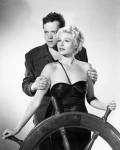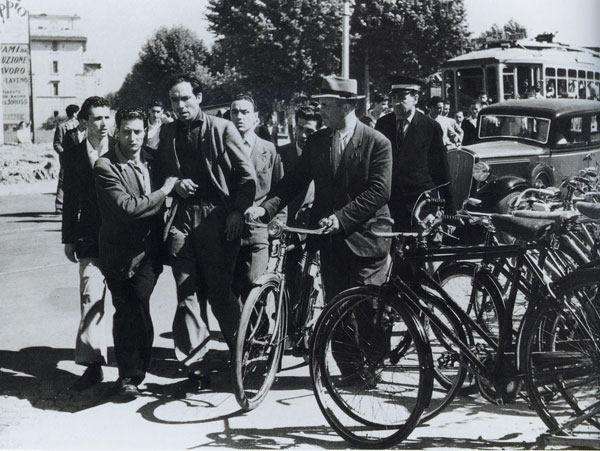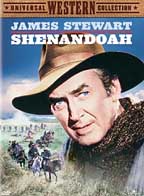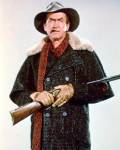 Who is the blogger?
Who is the blogger?
To see a simple English version of reviews about some of the movies, click on the ESL section of Midnight Oil.
Entries in drama (34)
The Lady From Shanghai (1947)
 “The Lady from Shanghai” (1947) stars Rita Hayworth as Elsa Bannister and Orson Welles as Micahel O’Hara. Welles does it all as principle actor, writer and director of the movie. It is an interesting film from more than one angle (à la crazy fun
“The Lady from Shanghai” (1947) stars Rita Hayworth as Elsa Bannister and Orson Welles as Micahel O’Hara. Welles does it all as principle actor, writer and director of the movie. It is an interesting film from more than one angle (à la crazy fun  house mirrors of the climax scene). Hayworth and Welles were in the final phases of their off-screen relationship at the time of filming, Welles reported that he did the film simply as a way of financing other projects in jeopardy, and the complicated plot of the original Sherwood King novel is just, well, hard to follow. But then, Michael O’Hara’s Irish brogue is rather hard to follow and even harder to swallow at times.
house mirrors of the climax scene). Hayworth and Welles were in the final phases of their off-screen relationship at the time of filming, Welles reported that he did the film simply as a way of financing other projects in jeopardy, and the complicated plot of the original Sherwood King novel is just, well, hard to follow. But then, Michael O’Hara’s Irish brogue is rather hard to follow and even harder to swallow at times.
 Rita Hayworth’s character is the rather too obvious femme fatale who spices up the exotic scenery and even indulges us with a musical number and a spectacular cliff diving scene for the benefit of box office sales. It’s film noir with more than the usual twist at the end with a visually discombobulating fun house scene that is all “Orson”. It can be fun, if you just relax and get into the
Rita Hayworth’s character is the rather too obvious femme fatale who spices up the exotic scenery and even indulges us with a musical number and a spectacular cliff diving scene for the benefit of box office sales. It’s film noir with more than the usual twist at the end with a visually discombobulating fun house scene that is all “Orson”. It can be fun, if you just relax and get into the  genre and the period of Hollywood film making.
genre and the period of Hollywood film making.
>>More to see: Looking for more out of life?
>>Real Life Story: Katie and Nathan realized that they were driving each other into someone else’s arms. See the real life turnaround in their marriage.
Orson Welles as Michael O’Hara gives us his rendition of the poetic Irish soul in this famous “shark scene on video clip. See below a re-cut, remixed video trailer for “The Lady From Shanghai” (1947)
Apollo 13 (1995)
 “Apollo 13” (1995), directed by Ron Howard, provides a wonderfully realistic dramatization of the historic aborted moon voyage of 1970. There was a PG rating on the film for language and emotional intensity. I appreciated the warning as the parent of a 10 year old who remains fascinated by gadgets, gizmos and galaxies but who
“Apollo 13” (1995), directed by Ron Howard, provides a wonderfully realistic dramatization of the historic aborted moon voyage of 1970. There was a PG rating on the film for language and emotional intensity. I appreciated the warning as the parent of a 10 year old who remains fascinated by gadgets, gizmos and galaxies but who  gets slightly stressed out by the super suspenseful inner states of being that sell movies. You really do want to make sure that you go to the bathroom before you start out on this two hour “disasterful” cinematic voyage to the moon and back. Tom Hanks, Bill Paxton and Kevin Bacon (playing astronauts Lovell, Haise and Swigert) form a triumvirate for outer space. Ed Harris provides ground support as Flight Director Gene Kranz. Well, there was that other guy, Gary Sinise. He plays astronaut Ken Mattingly. That’s the fellow who gets knocked off of the roster at the last minute by
gets slightly stressed out by the super suspenseful inner states of being that sell movies. You really do want to make sure that you go to the bathroom before you start out on this two hour “disasterful” cinematic voyage to the moon and back. Tom Hanks, Bill Paxton and Kevin Bacon (playing astronauts Lovell, Haise and Swigert) form a triumvirate for outer space. Ed Harris provides ground support as Flight Director Gene Kranz. Well, there was that other guy, Gary Sinise. He plays astronaut Ken Mattingly. That’s the fellow who gets knocked off of the roster at the last minute by  German measles - but no one ever mentions him. They did manage, in the name of historical accuracy, to mention the fact that the unfortunate Pilot Haise, played by Bill Paxton, got a major urinary tract infection due to not drinking enough water during the mission. Too much
German measles - but no one ever mentions him. They did manage, in the name of historical accuracy, to mention the fact that the unfortunate Pilot Haise, played by Bill Paxton, got a major urinary tract infection due to not drinking enough water during the mission. Too much  information.
information.
Methinks there was a bit too much testosterone floating around the stratosphere in this film. In the end, everyone keeps their head and all get back to earth safely. I really wasn’t sure there for a few minutes – and that was after seeing the film previously and living through the historical event. When they are done right, movies can be an engrossing form of storytelling. This one was done right.
>>More to see: Looking for more out of life?
>>Real Life Story: Darrell Waltrip was a great success as a NASCAR driver until a near fatal accident changed his direction in life.
View the video trailer for "Apollo 13" (1995)
Clean and Sober (1988)
 “Clean and Sober” (1988) with Michael Keaton, Kathy Baker and Morgan Freeman makes for a hard-hitting onscreen drama about addiction that has seldom been surpassed. Keaton’s performance as the self-absorbed Daryl Poynter, real estate agent, coke addict and all around jerk, is simply excellent. The façade of the high roller slowly unravels. The action of the film takes place over the course of one calendar month in the life of the addict. Instead of being the guy pulling the strings behind the scenes, Daryl Poynter comes to see that he is not in control. His life is one big, tangled mess. It’s a hard pill to swallow.
“Clean and Sober” (1988) with Michael Keaton, Kathy Baker and Morgan Freeman makes for a hard-hitting onscreen drama about addiction that has seldom been surpassed. Keaton’s performance as the self-absorbed Daryl Poynter, real estate agent, coke addict and all around jerk, is simply excellent. The façade of the high roller slowly unravels. The action of the film takes place over the course of one calendar month in the life of the addict. Instead of being the guy pulling the strings behind the scenes, Daryl Poynter comes to see that he is not in control. His life is one big, tangled mess. It’s a hard pill to swallow.
 Through the unintended help of people like his rehab counselor (Morgan Freeman), his A.A. sponsor (M. Emmet Walsh ) and others, Daryl Poynter gets a major dose of reality therapy just in time. We see him actually undergo a step of evolution and graduate from the level of “pond scum” (the scene where he cons his old mother on the phone) to semi-human status (the scene where he tries
Through the unintended help of people like his rehab counselor (Morgan Freeman), his A.A. sponsor (M. Emmet Walsh ) and others, Daryl Poynter gets a major dose of reality therapy just in time. We see him actually undergo a step of evolution and graduate from the level of “pond scum” (the scene where he cons his old mother on the phone) to semi-human status (the scene where he tries  to help his fellow addict, Charlie, make the phone call to exit her abusive relationship). It’s not easy. It’s not meant to be an easy film. Keaton’s masterful closing scene at the A.A. meeting is painful to watch – a man so uneasy in his own skin that you think he might just crawl out of it. In the end, the film helps one to understand that the uneasiness of it all is necessary if there is to be a hope in hell of recovery.
to help his fellow addict, Charlie, make the phone call to exit her abusive relationship). It’s not easy. It’s not meant to be an easy film. Keaton’s masterful closing scene at the A.A. meeting is painful to watch – a man so uneasy in his own skin that you think he might just crawl out of it. In the end, the film helps one to understand that the uneasiness of it all is necessary if there is to be a hope in hell of recovery.
Also reviewed on this blog is another feature screened on TVO's Saturday Night at the Movies "Days of Wine and Roses" (1962) with Jack Lemmon and Lee Remick.
>>More to see: Looking for more out of life?
>> Real life story, Brian Welch: finding a way out of addiction.
See the video trailer for "Clean and Sober" (1988).
The Bicycle Thief (1948)
 “The Bicycle Thief” (1948), is a small masterpiece on celluloid that captures the human drama of a family man struggling to maintain his livelihood and his dignity by recovering a stolen bicycle in post-war Rome. This Italian language film by Vittorio de Sica maintained my interest even with the English subtitles. Taking in a film through translation may be akin to listening to a symphony orchestra through a tin can telephone. One is sure to miss something in the translation. However, the acting on the part of the father and son duo (played
“The Bicycle Thief” (1948), is a small masterpiece on celluloid that captures the human drama of a family man struggling to maintain his livelihood and his dignity by recovering a stolen bicycle in post-war Rome. This Italian language film by Vittorio de Sica maintained my interest even with the English subtitles. Taking in a film through translation may be akin to listening to a symphony orchestra through a tin can telephone. One is sure to miss something in the translation. However, the acting on the part of the father and son duo (played  by Lamberto Maggiorani and Enzo Staiolo respectively) is so convincing both through dialogue and the non-verbal, that one can forgive the ongoing necessity of the subtitles. Following the everyman character about the streets of Rome in his desperate search for his bicycle gives us the full range of an emotional workout and a depth of sociological analysis that the “official bus tour” of the famous Eternal City would never afford.
by Lamberto Maggiorani and Enzo Staiolo respectively) is so convincing both through dialogue and the non-verbal, that one can forgive the ongoing necessity of the subtitles. Following the everyman character about the streets of Rome in his desperate search for his bicycle gives us the full range of an emotional workout and a depth of sociological analysis that the “official bus tour” of the famous Eternal City would never afford.
>>More to see: Looking for more out of life?
See a trailer for "The Bicycle Thief" (1948)
Shenandoah (1965)
 “Shenandoah” (1965) IMDb with James Stewart playing the lead role provides a less than usual perspective on the American Civil War. The film tells the story of a well ensconced Virginian farming family caught up in the latter part of the Civil War. Stewart, as Charlie Anderson, vehiculates a pragmatic pacificism about a mean and dirty war that now encroaches on his land and his family. Anderson himself is not undergirded by a particularly robust morality about the war nor about his position on pacificism. He finds himself fighting a losing battle even though he technically remains “out of the war”.
“Shenandoah” (1965) IMDb with James Stewart playing the lead role provides a less than usual perspective on the American Civil War. The film tells the story of a well ensconced Virginian farming family caught up in the latter part of the Civil War. Stewart, as Charlie Anderson, vehiculates a pragmatic pacificism about a mean and dirty war that now encroaches on his land and his family. Anderson himself is not undergirded by a particularly robust morality about the war nor about his position on pacificism. He finds himself fighting a losing battle even though he technically remains “out of the war”.
 The Uncivil War episode offered by Saturday Night at the Movies pairs “Ride with the Devil” (1995) IMDb with this movie classic from 1965. SNAM’s interviewed guests bring out the relationship of “Shenandoah” with American sentiments of the day concerning young American men snatched up into the war in Vietnam and the accompanying anger, confusion and sense of helplessness on the part of those at home.
The Uncivil War episode offered by Saturday Night at the Movies pairs “Ride with the Devil” (1995) IMDb with this movie classic from 1965. SNAM’s interviewed guests bring out the relationship of “Shenandoah” with American sentiments of the day concerning young American men snatched up into the war in Vietnam and the accompanying anger, confusion and sense of helplessness on the part of those at home.
>>More to see: Looking for more out of life?
See the SNAM preview for The Uncivil War here. Dig in to the background for the films through the Interviews on The Uncivil War with experts on the period.
Catch the video trailer for “Shenandoah” (1965) here.




